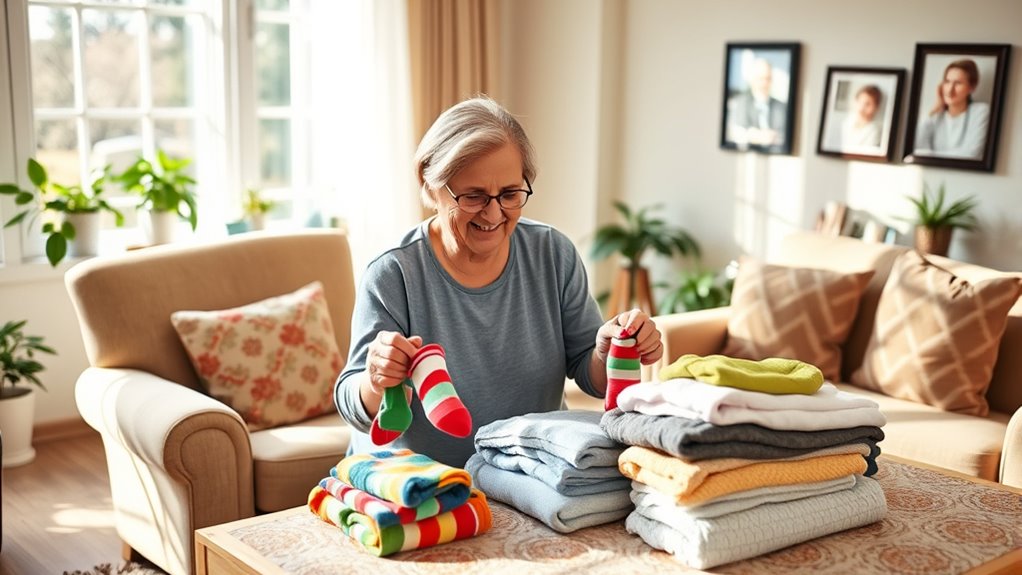To keep your loved one with dementia engaged and active, try simple activities like arts and crafts that stimulate creativity, along with music and movement to boost mood and physical health. Incorporate sensory experiences such as tactile objects, aromatherapy, and outdoor walks to evoke memories and promote calmness. Reminiscence exercises and routine tasks also help maintain a sense of purpose. Exploring these approaches can bring joy and connection—continue to discover more ways to enrich their daily life.
Key Takeaways
- Engage in simple arts and crafts to stimulate creativity, fine motor skills, and provide a sense of achievement.
- Incorporate music, dance, and sensory activities to boost mood, physical activity, and emotional well-being.
- Use reminiscence and memory exercises, like photo sharing, to reinforce personal identity and emotional comfort.
- Promote outdoor activities and nature interactions for physical stimulation and mental engagement.
- Integrate routine tasks and meaningful activities to provide structure, purpose, and promote independence.
Simple Arts and Crafts to Spark Creativity

Engaging in simple arts and crafts can be a wonderful way to stimulate creativity and provide enjoyment for dementia patients. DIY projects like making paper crafts are easy and accessible, helping to boost their confidence and sense of accomplishment. You can encourage your loved one to create colorful cards, paper flowers, or simple collages using materials like construction paper, stickers, and glue. These activities not only engage their hands but also stimulate their minds by encouraging focus and fine motor skills. Keep the projects straightforward, and offer plenty of encouragement. The goal is to foster a sense of achievement and joy, while also providing a calming, hands-on activity that can brighten their day. Simple paper crafts are perfect for sparking creativity without overwhelming them. Incorporating diverse design options can further inspire their imagination and make the activity more engaging. Exploring different artistic techniques can also add variety and keep their interest alive. Additionally, choosing activities that are aligned with their individual interests can enhance their engagement and enjoyment. Utilizing secure and easy-to-use materials ensures safety and comfort during craft activities, making the experience more positive. Engaging in activities that align with their personal preferences can also promote a sense of familiarity and comfort.
Music and Movement for Physical and Emotional Well-Being

After exploring simple arts and crafts to spark creativity, incorporating music and movement can further enhance a dementia patient’s well-being. Dance therapy offers a gentle way to encourage physical activity while boosting mood and emotional connection. You can lead your loved one in simple dance routines or encourage free movement to familiar tunes. Musical improvisation also works well; playing instruments or singing together stimulates cognition and evokes positive memories. These activities promote coordination, balance, and social interaction, helping to reduce agitation and increase feelings of joy. Necessary Cookies are essential for maintaining the basic functionality of online activities, including those related to engaging with music and movement exercises. Incorporating dynamic communication exercises into daily routines can also foster a stronger emotional bond and improve understanding between caregivers and patients. Engaging in music and movement activities can activate brain regions involved in memory and emotion, further supporting cognitive health. Additionally, these activities can stimulate neuroplasticity, encouraging the brain to form new connections and adapt positively. By integrating music and movement into daily routines, you create a lively, engaging environment that supports both physical health and emotional stability for your loved one.
Sensory Activities to Stimulate the Senses

Sensory activities can greatly enhance engagement and comfort for dementia patients. You can incorporate tactile stimulation, aromatherapy, and sound or music to create a calming and stimulating environment. These techniques help connect patients to their senses and promote well-being. Incorporating self watering plant pots into daily routines can also help reduce agitation and improve mood. Additionally, engaging patients in body awareness activities can foster a stronger mind-body connection, offering further comfort and emotional support. Incorporating sensory stimulation techniques tailored to individual preferences can further boost their effectiveness.
Tactile Stimulation Techniques
Tactile stimulation techniques are essential for providing dementia patients with meaningful sensory experiences that can enhance their comfort and engagement. One effective method is tactile storytelling, where you use textured objects to create a multisensory narrative. As you guide your loved one’s hands over different textures—such as soft fabric, rough bark, or smooth stones—they connect with the story through touch. Incorporate textured objects that evoke memories or stimulate curiosity, helping to spark conversation and emotional responses. Keep objects familiar and safe, and encourage exploration at their own pace. These tactile activities not only promote sensory engagement but also foster a sense of connection and reassurance, making each session both enjoyable and meaningful for your loved one. Additionally, selecting appropriate sensory tools can maximize the benefits of tactile stimulation by ensuring safety and comfort during engagement. Using tools with the right material properties can further enhance tactile experiences and support comfort during exploration, especially when considering sensory processing differences common in dementia patients. Incorporating knowledge of natural techniques for successful commercial seed production can inspire innovative ways to create engaging, natural sensory activities that promote well-being.
Aromatherapy and Scents
Aromatherapy and scent-based activities can be powerful tools for stimulating memory and emotions in dementia patients. Using essential oils, you can create calming or invigorating environments through scent therapy, which helps engage their senses. Simple activities like diffusing lavender or peppermint oil can reduce anxiety or boost alertness. You might also encourage your loved one to smell different herbs or scented objects, prompting recognition and discussion. These scent-based activities tap into the brain’s strong connection between smell and memory, often triggering familiar feelings or memories. Incorporating aromatic cleaning with essential oils can also promote a sense of freshness and well-being in the environment. Additionally, understanding sensory stimulation techniques can help tailor activities to your loved one’s preferences and needs. Always verify the essential oils are safe and used in moderation. Using aroma therapy consciously can further enhance the therapeutic effects and create a more immersive sensory experience. Integrating AI security insights regarding safety measures can help ensure that scent activities are administered securely and effectively, especially when using diffusers or other electronic devices. Incorporating aromatherapy into daily routines can enhance emotional well-being and provide comfort for your loved one. As noted in Ancient Egyptian wisdom, the importance of harmony and balance in life aligns with creating a soothing scent environment that promotes peace and stability.
Sound and Music Engagement
Engaging dementia patients with sound and music can substantially enhance their emotional and cognitive well-being. Musical therapy, in particular, offers a powerful way to evoke memories and improve mood. You can incorporate sound visualization by playing familiar tunes or nature sounds to stimulate senses and promote relaxation. Here are some effective activities:
- Play favorite music to spark recognition and joy.
- Use musical instruments like drums or maracas for simple rhythm exercises.
- Create soundscapes with nature sounds to evoke calming feelings.
- Explore sound visualization apps that sync music with visual effects to stimulate the senses.
These activities help foster connection, reduce anxiety, and keep your loved ones engaged through the therapeutic power of sound and music.
Reminiscence and Memory-Based Exercises

Reminiscence and memory-based exercises are valuable tools for stimulating mental activity and fostering a sense of identity in dementia patients. You can encourage life story sharing, where they talk about past experiences, helping to reinforce their personal history. Using photo album reminiscing, you guide them through familiar images, prompting stories and emotions connected to those memories. These activities not only engage their minds but also strengthen emotional bonds and boost self-esteem. Keep the environment relaxed and supportive, allowing your loved one to express themselves without pressure. By focusing on meaningful memories, you help preserve their sense of self and provide comfort, making these exercises enjoyable and enriching for both of you.
Nature and Outdoor Engagements

Spending time outdoors offers dementia patients an invigorating way to reconnect with their environment and stimulate their senses. Outdoor engagement promotes physical activity, mental stimulation, and emotional well-being. Gardening therapy is a gentle way to encourage touch, smell, and sight, providing a calming effect. You can also plan outdoor exploration, such as nature walks or observing wildlife, to spark curiosity. Here are some ideas to get started:
Spending time outdoors stimulates senses, promotes well-being, and fosters joy through nature exploration and gardening therapy.
- Create a small garden or flower bed for hands-on gardening therapy.
- Take leisurely strolls in a park or natural setting to enjoy fresh air and scenery.
- Use sensory plants like herbs or fragrant flowers to enhance outdoor exploration.
- Set up bird feeders or butterfly gardens to attract wildlife and inspire interaction.
These activities help foster connection and joy through nature.
Everyday Tasks and Routine Activities

Incorporating everyday tasks into a routine can provide dementia patients with a sense of purpose and independence. Simple activities like daily grooming, such as brushing hair or washing hands, help maintain their dignity and self-care skills. Meal preparation is another valuable activity; involve them in setting the table, chopping vegetables, or stirring ingredients. These tasks encourage engagement and foster a feeling of contribution. Establishing a consistent schedule for these routines creates stability and reduces confusion. Keep instructions clear and tasks manageable to boost confidence. Celebrating small successes during daily grooming or meal prep reinforces their abilities. By integrating these routine activities into daily life, you help your loved one stay active, retain independence, and feel more connected to their everyday environment.
Frequently Asked Questions
How Can Activities Be Adapted for Different Stages of Dementia?
When adapting activities for different stages of dementia, you should consider their changing abilities. Early on, incorporate memory games and art therapy to stimulate cognition and creativity. As the disease progresses, simplify tasks, focus on sensory experiences, and use familiar objects. You’ll want to remain flexible, offering encouragement and adjusting activities to match their current needs, ensuring engagement remains meaningful and comfortable throughout each stage.
What Safety Precautions Are Necessary During Outdoor Activities?
When taking your loved one outdoors, prioritize safety by using appropriate safety gear like helmets or harnesses if needed. Keep a close eye on environmental hazards such as uneven ground, busy streets, or harmful plants. Stay within safe, familiar areas, and always supervise closely. Prepare a first aid kit and make sure your phone is charged. Being vigilant helps prevent accidents and keeps outdoor activities enjoyable and safe for your loved one.
How Can Family Members Effectively Motivate Participation?
You can effectively motivate participation by using motivation techniques like offering gentle encouragement and positive reinforcement. Engagement strategies such as choosing activities aligned with their interests or past hobbies make participation more appealing. Remember to be patient and flexible, adjusting activities as needed. Your support and understanding help boost their confidence, making them more likely to stay engaged and enjoy the experience. This approach fosters a sense of accomplishment and connection.
Are There Specific Activities Suitable for Advanced Dementia?
Think of a gentle lighthouse guiding ships through fog; for advanced dementia, simple, soothing activities can be just as comforting. You can use music therapy to evoke memories and calm nerves, while art activities like finger painting provide sensory engagement without frustration. These activities symbolize connection and peace, helping your loved one feel valued and safe even in later stages of dementia.
How Can Activities Be Personalized to Individual Preferences?
To personalize activities, focus on your loved one’s unique preferences. Incorporate music therapy with their favorite songs or genres to evoke positive memories. Try art activities that reflect their interests, like painting or crafting familiar objects. Observe their reactions to different activities and adjust accordingly. This tailored approach boosts engagement and comfort, making each activity meaningful. Your attentiveness helps create a supportive environment that respects their individuality.
Conclusion
Think of engaging your loved one with dementia as tending a delicate garden. With patience and creativity, you nurture their spirit and help memories blossom anew. Each activity is like water and sunlight, fueling their connection to the world around them. By staying active and engaged, you become the gentle gardener, cultivating joy and purpose in their daily life. Together, you create a vibrant, thriving garden that blooms with love and understanding.









